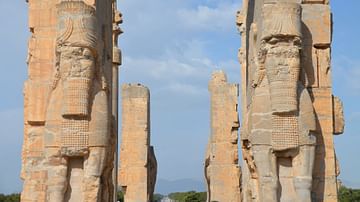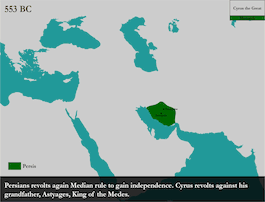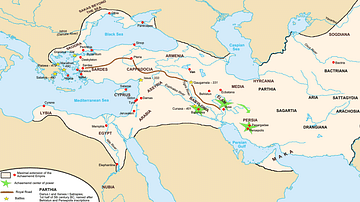Illustration
Western view of the "All Nations Gate" at Persepolis, located in present-day Iran. This gate was not on Darius the Great's initial plan for Persepolis but was added by his son and successor, Xerxes.
The initial main entrance of the palace complex was located on the south wall of the terrace supporting the palaces. Xerxes changed it, adding a monumental stairway on the west side leading to that gate upstairs. The function of the gate was not only to allow the entry of the visitors, but was also to separate the people according to their social importance.
The gate was a square hypostyle hall with three doors. The few nobles and princes allowed to enter the royal palace were directed through the south door to a court opening on the Tachara (Darius' audience hall) or to the Tripylon palace, while the others were directed trough the east door on an alley leading to another gate (unfinished), and then the east barracks or to the 100 column palace.
The 4 columns are well preserved and supported a 18.5 meters high roof. The columns are ionian stylized, erected on inversed bell shapes, their top consisted in stylized palm trees. The walls were decorated with 2 giant bulls on the west, and 2 giant lamassus (androcephalic winged bulls) on the east protecting the path. The gate carries also a royal trilingual Achaemenid cuneiform inscription by Xerxes.
References
- All nations gate on Flickr - Photo Sharing!Accessed 1 Dec 2016.
Cite This Work
APA Style
dynamosquito, . (2012, April 26). All Nations Gate at Persepolis. World History Encyclopedia. Retrieved from https://www.worldhistory.org/image/83/all-nations-gate-at-persepolis/
Chicago Style
dynamosquito, . "All Nations Gate at Persepolis." World History Encyclopedia. Last modified April 26, 2012. https://www.worldhistory.org/image/83/all-nations-gate-at-persepolis/.
MLA Style
dynamosquito, . "All Nations Gate at Persepolis." World History Encyclopedia. World History Encyclopedia, 26 Apr 2012. Web. 30 Apr 2024.






